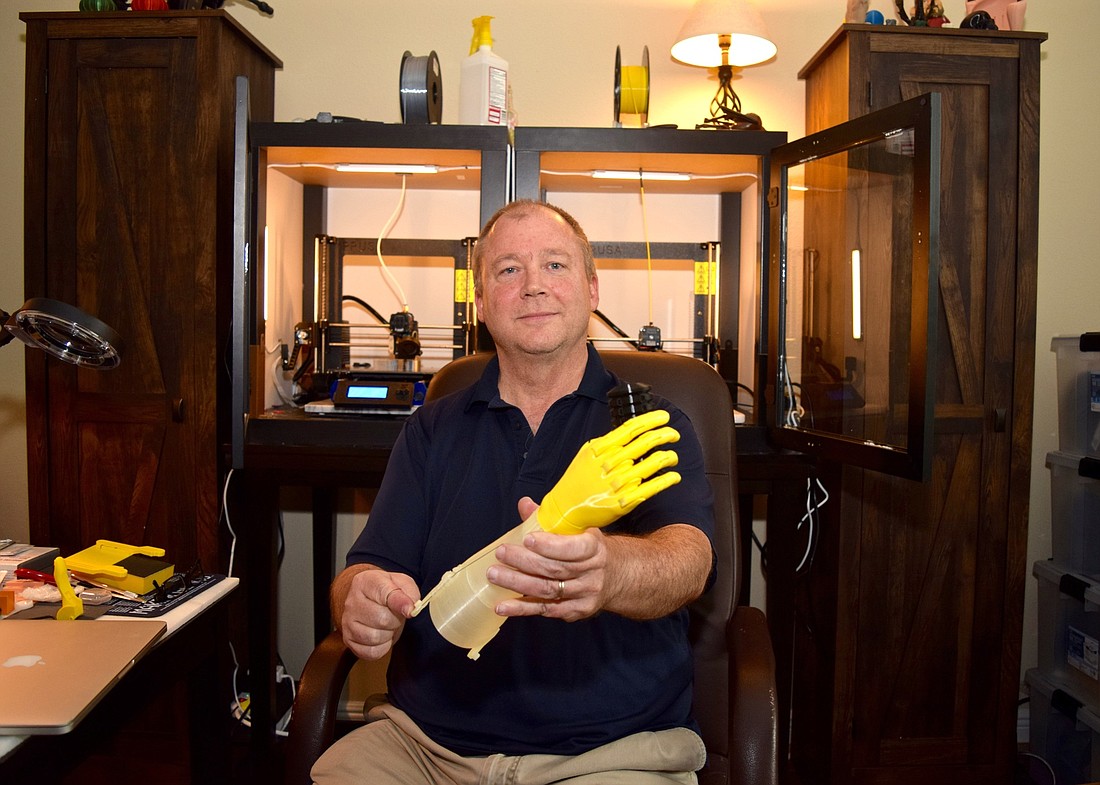- April 18, 2024
-
-
Loading

Loading

It all started with a broken leg, a 3D printer and a replacement lever for a soap dispenser.
In April 2017, Winter Garden resident Barry Maxwell was temporarily homebound and in a wheelchair after breaking his leg. Unable to easily go up and down the stairs in his home, he needed a new hobby that he could enjoy downstairs to occupy his mind.
So, he decided to buy a 3D printer. One of the first things he made was a replacement lever for a soap dispenser in his home. He also helped his daughter by making a few parts for her jewelry, which she sells on Etsy.
Fast-forward to today, and Maxwell has put his newest hobby to good use by creating and building 3D-printed prosthetic limbs for children who need them.
For Maxwell, the choice to get into 3D printing was simple.
“It speaks to the engineer in me — even though I’m not an engineer — but it’s something hands-on you can do and make interesting things with,” said Maxwell, a former U.S. Navy aviator who now works for a defense contractor. “It just seemed like a fun thing. You learn about how they work. The software (is) standard downloadable software, open-source for design and hardware. There’s a very large thriving community around it.”
He now has two Prusa-brand 3D printers in his workshop downstairs, and he constantly is thinking of things he can make with them. After tinkering around in the beginning by making figurines, household items and little toys for neighborhood children, it was time to look at the bigger picture.
“There are only so many things in the house you can fix,” he said. “I’d seen things on 3D-printed hands and prosthetics before, and I found a couple of organizations that I kind of work and cooperate with to do it.”
Maxwell works with three organizations — Enabling the Future, ENABLE Alliance and the Million Waves Project — to create 3D-printed prosthetic hands for children on a case-by-case basis, as well as kits that can be assembled by Boy Scout troops or students.
“(If) one organization says, ‘Hey, I need five, 10, 15 of this, can you make those?’ I make and send them off and they have Boy Scout troops or schools or whatever assemble them, and then they get sent off all of the world,” he said. “Some of the hands I’ve made are in Nepal being used. Some went to Canada and Mexico. They literally send all over the world.”
Because Maxwell is qualified to create prosthetic hands with Enabling the Future, he has access to a web interface that allows him to search for cases worldwide of people who are in need of limbs.
“Some of them are from amputations, birth defects or defects of war,” he said. “I like to help kids, because most doctors’ prostheses won’t fit children, because they outgrow them. A true professional prosthetic costs thousands of dollars, especially if you want it to do anything (functional). Otherwise, they just make one for appearance. With this, they can get something that is functional and yet is not going to cost them. It costs them nothing; this is all done by volunteers.”
Most recently he has made hands and prosthetic limbs for two little girls, 5-year-old Blakeley and 6-year-old Elizabeth, through Enabling the Future. Elizabeth, who lives in Alabama, was born with a partial hand. Thanks to Maxwell and Enabling the Future, she has a prosthetic now that allows her to ride her bike. Blakeley, who lives in Oregon, had amniotic band syndrome and her arm stopped about halfway down the forearm. She can now grip and pick up her toys as she plays.
Maxwell also partners with ENABLE Alliance, a nonprofit dedicated to supporting schools, scout troops, robotics teams and more who are using 3D-printed technology to create positive change in the world. Maxwell prints kits and sends them to the organization, which then distributes them to students and children for assembly and learning. Additionally, he works with the Million Waves Project, which takes recycled plastic cleaned from the ocean and turns it into 3D-printable material, or filament.
Maxwell’s hands are mechanical. The trick is customizing it to the individual in need. The basic design must be printed to size, which requires measurements such as arm length, hand length and wrist width to match the prosthetic to the good hand. This takes a couple of hours, but once files are generated, it’s time to print. Depending on complexity, the whole process can take between 20 and 30 hours.
Once assembly begins, it takes about two hours to fit everything properly and run the lines, which control the functionality of the fingers. If the hand includes an arm, recipients wear a sleeve around their biceps or forearm and slide it into the 3D arm. Then, a printed plate attached to the arm is formed around the biceps and strapped on with Velcro and padding.
“I tend to concentrate on kids more because everybody has a need, but to me, it has more of an impact if you can give a kid abilities that they didn’t have before,” he said. “To be able to have an impact on a child’s life like that, to me, is satisfying.”
And his wife, Diana, is amazed at how his broken leg turned into something so positive.
“He sets (the printer) up in the morning and goes to print (the pieces),” she said. “I check on them throughout the day, and they’re done by the time he gets home. ... I never thought when he bought this how it could change someone else’s life.”